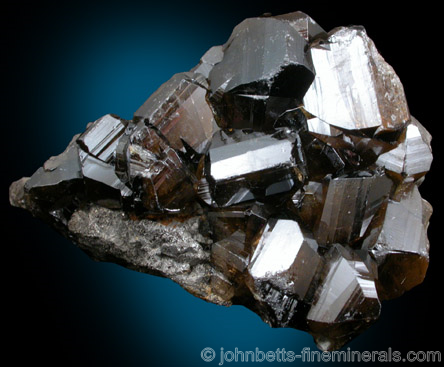The Mineral cassiterite

Cassiterite is the best-known tin mineral. It has been used as the chief ore of tin from early history throughout the ages, and remains so even today. Some of the economical Cassiterite deposits exist in placer stream deposits where this very heavy mineral collects as rounded waterworn pebbles. The name Cassiterite is derived from the Greek "kassiteros", meaning tin.
Color
Black, brown, reddish-black, reddish-brown, yellowish-brown. Rarely yellow or gray. The variety Wood Tin is banded with inner concentric, ring-like band growths.
Crystal System
Tetragonal
Properties
Streak
Pale brown |
Hardness
6 - 7 |
Transparency
Transparent to opaque |
Specific Gravity
6.8 - 7.1 |
Luster
Greasy, adamantine, dull |
Cleavage
2,4 |
Fracture
Uneven |
Tenacity
Brittle |
Uses
Cassiterite is an economically important mineral, being the primary ore of the metal tin. It is also used as a collectors mineral with the transparent forms being highly desired. Cassiterite is occasionally used as a minor gemstone, being faceted mostly for collectors.
Noteworthy Localities
Bolivia produces some of the finest Cassiterite specimens in abundance. Bolivian locations where lustrous and sometimes transparent crystals come from include Viloco (Araca), Loayza Province; Huanuni, Dalence Province, Oruro Department; and Llallagua, Potosi Department. Some of the Brazilian gem pegmatite in Minas Gerais have produced good specimens, especially Linópolis, in the Doce valley.
China has also become an important producer of Cassisterite, with outstanding shiny black crystals originating in several localities including Mt. Xuebaoding, Pingwu, Sichuan Province; the Yaogangxian Mine, Hunan Province; and Dayu, Jiangxi Province. Transparent brown crystals come from Ximeng, Yunnan Province, China. In Russia, excellent lustrous crystals come from Merekski, Khabarovskiy Kraj.
In Europe, one of the most classic localities of Cassiterite is Krásno and Horní Slavkov (Schlaggenwald), Bohemia, Czech Republic. Also in Bohemia is Krupka, Krušné Hory; and similar crystals are found in a similar geological deposit across the German border at Ehrenfriedersdorf, Erzgebirge, in Saxony. Cornwall, England, has produced classic specimens in several deposits; especially noteworthy are the Redruth-St. Day and St. Agnes Districts. Other important European localities include La Villeder, Le Roc Saint-André, France; Panasqueira, Portugal; and Penouta, Spain.
In Australia, transparent brown crystals come from the Aberfoyle Mine, Rossarden, Tasmania; and fairly large crystals from Elsmore, New South Wales.
Cassiterite is not common in the U.S. Some of the gem pegmatite deposits, especially those in southern California and New England have produced sporadic Cassiterite. Some specific good localities include Greenwood, Oxford Co., Maine; Amelia, Amelia Co., Virginia; and Taylor Creek, Sierra Co., New Mexico. In Mexico, noteworthy reniform and botryoidal "Wood Tin" come from an unspecified locality in Durango.
Distingushing Similar Minerals
Schorl - Greater hardness and lower specific gravity.
Rutile, Ilvaite, Vesuvianite, & Columbite - Lower specific gravity.